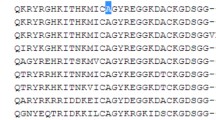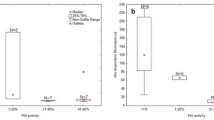Abstract
Hereditary coagulation factor XI (FXI) deficiency is a rare bleeding disorder, but information on FXI deficiency in Taiwanese patients remains scarce. We evaluated clinical and genetic features of severe FXI deficiency patients in Taiwan. We collected clinical information and performed coagulation laboratory tests and genetic studies in ten unrelated Taiwanese families with severe FXI deficiency. FXI coagulation activity was assayed using a one-stage method. FXI antigen was determined using enzyme-linked immunosorbent assay. Underlying genetic mutations were evaluated using direct sequencing methods. Ten unrelated Taiwanese patients with hereditary FXI deficiency and variable bleeding tendencies were analyzed. Half of the patients were male. The most common bleeding manifestations were easy bruising (40%), bleeding after dental procedures (40%), and postoperative bleeding (33%). Two patients (20%) were asymptomatic. No correlation was found between bleeding manifestations and baseline FXI levels. Three novel mutations were identified: c.1322delT p.Lys442Cysfs*8, c.599G > C p.Cys200Ser, and IVS4 c.325 + 2del124. Two common mutations, c.1107C > T p.Tyr369* (40%) and c.841C > T p.Gln281* (30%), were also found. No correlation existed between bleeding and FXI activity, highlighting the difficulty in predicting FXI deficiency-related bleeding. Three novel FXI genetic mutations and two common mutations were identified, contributing to the known spectrum of FXI deficiency-related mutations.

Similar content being viewed by others
References
Emsley J, McEwan PA, Gailani D. Structure and function of factor XI. Blood. 2010;115:2569–77.
Bouma BN, Meijers JC. Role of blood coagulation factor XI in downregulation of fibrinolysis. Curr Opin Hematol. 2000;7:266–72.
Rosenthal RL, Dreskin OH, Rosenthal N. New hemophilia-like disease caused by deficiency of a third plasma thromboplastin factor. Proc Soc Exp Biol Med. 1953;82:171–4.
Bolton-Maggs PH, Patterson DA, Wensley RT, Tuddenham EG. Definition of the bleeding tendency in factor XI-deficient kindreds–a clinical and laboratory study. ThrombHaemost. 1995;73:194–202.
Brenner B, Laor A, Lupo H, Zivelin A, Lanir N, Seligsohn U. Bleeding predictors in factor-XI-deficient patients. Blood Coagul Fibrinolysis. 1997;8:511–5.
Ragni MV, Sinha D, Seaman F, Lewis JH, Spero JA, Walsh PN. Comparison of bleeding tendency, factor XI coagulant activity, and factor XI antigen in 25 factor XI-deficient kindreds. Blood. 1985;65:719–24.
Seligsohn U. High gene frequency of factor XI (PTA) deficiency in Ashkenazi Jews. Blood. 1978;51:1223–8.
Shpilberg O, Peretz H, Zivelin A, Yatuv R, Chetrit A, Kulka T, et al. One of the two common mutations causing factor XI deficiency in Ashkenazi Jews (type II) is also prevalent in Iraqi Jews, who represent the ancient gene pool of Jews. Blood. 1995;85:429–32.
World Federation of Hemophilia. Report on the annual global survey 2017. Montréal: World Federation of Hemophilia; 2018.
Peyvandi F, Palla R, Menegatti M, Siboni SM, Halimeh S, Faeser B, et al. Coagulation factor activity and clinical bleeding severity in rare bleeding disorders: results from the European Network of Rare Bleeding Disorders. J Thromb Haemost. 2012;10:615–21.
Martincic D, Kravtsov V, Gailani D. Factor XI messenger RNA in human platelets. Blood. 1999;94:3397–404.
den Dunnen JT, Dalgleish R, Maglott DR, Hart RK, Greenblatt MS, McGowan-Jordan J, et al. HGVS recommendations for the description of sequence variants: 2016 update. Hum Mutat. 2016;37:564–9.
Asakai R, Davie EW, Chung DW. Organization of the gene for human factor XI. Biochemistry. 1987;26:7221–8.
Peyvandi F, Di Michele D, Bolton-Maggs PH, Lee CA, Tripodi A, Srivastava A. Project on Consensus Definitions in Rare Bleeding Disorders of the factor VIII/factor IX Scientific and Standardisation Committee of the Internaltional Society on Thrombosis and Haemostasis. Classification of rare bleeding disorders (RBDs) based on the association between coagulant factor activity and clinical bleeding severity. J Thromb Haemost. 2012;10:1938–43.
Santoro C, Di Mauro R, Baldacci E, De Angelis F, Abbruzzese R, Barone R, et al. Bleeding phenotype and correlation with factor XI (FXI) activity in congenital FXI deficiency: results of a retrospective study from a single centre. Haemophilia. 2015;21:196–501.
Drakulic M, Chai-Adisaksopha C, Iorio A. Clinical and biological determinants of bleeding manifestation in congenital factor XI deficiency; a systematic review. Blood. 2016;128:1407.
Puy C, Rigg RA, McCarty OJ. The hemostatic role of factor XI. Thromb Res. 2016;141(Suppl 2):S8–S11.
Key NS. Epidemiologic and clinical data linking factors XI and XII to thrombosis. Hematology Am Soc Hematol Educ Program. 2014;2014:66–70.
Kato A, Asakai R, Davie EW, Aoki N. Factor XI gene (F11) is located on the distal end of the long arm of human chromosome 4. Cytogenet Cell Genet. 1989;52:77–8.
Mitchell M, Mountford R, Butler R, Alhaq A, Dai L, Savidge G, et al. Spectrum of factor XI (F11) mutations in the UK population–116 index cases and 140 mutations. Hum Mutat. 2006;27:829.
Bolton-Maggs PH, Butler R, Mountford R, Gailani D. Eleven novel mutations in non-Jewish factor XI deficient kindreds detected by SSCP with heteroduplex analysis followed by sequencing. J Thromb Haemost. 2003;1(Suppl. 1):P1687.
O'Connell NM, Saunders RE, Lee CA, Perry DJ, Perkins SJ. Structural interpretation of 42 mutations causing factor XI deficiency using homology modeling. J Thromb Haemost. 2005;3:127–38.
Lim KH, Ferraris L, Filloux ME, Raphael BJ, Fairbrother WG. Using positional distribution to identify splicing elements and predict pre-mRNA processing defects in human genes. PNAS. 2011;108:11093–8.
Asakai R, Chung DW, Ratnoff OD, Davie EW. Factor XI (plasma thromboplastin antecedent) deficiency in Ashkenazi Jews is a bleeding disorder that can result from three types of point mutations. Proc Natl Acad Sci U S A. 1989;86:7667–711.
Au WY, Cheung JW, Lam CC, Kwong YL. Two factor XI mutations in a Chinese family with factor XI deficiency. Am J Hematol. 2003;74:136–8.
Kawaguchi T, Koga S, Hongo H, Komiyama Y, Li K, Ishihara S, et al. A novel type of factor XI deficiency showing compound genetic abnormalities: a nonsense mutation and an impaired transcription. Int J Hematol. 2000;71:84–9.
Sato E, Kawamata N, Kato A, Oshimi K. A novel mutation that leads to a congenital factor XI deficiency in a Japanese family. Am J Hematol. 2000;63:165–9.
Kim J, Song J, Lyu CJ, Kim YR, Oh SH, Choi YC, et al. Population-specific spectrum of the F11 mutations in Koreans: evidence for a founder effect. Clin Genet. 2012;82:180–6.
Shao Y, Cao Y, Lu Y, Dai J, Ding Q, Wang X, et al. Clinical manifestations and mutation spectrum of 57 subjects with congenital factor XI deficiency in China. Blood Cells Mol Dis. 2016;58:29–34.
Okumura K, Kyotani M, Kawai R, Takagi A, Murate T, Yamamoto K, et al. Recurrent mutations of factor XI gene in Japanese. Int J Hematol. 2006;83:462–3.
Wu WM, Wang HL, Wang XF, Chu HY, Fu QH, Ding QL, et al. Identification of two novel factor XI non-sense mutation Trp228stop and Trp383stop in a Chinese pedigree of congenital factor XI deficiency. Zhonghua Xue Ye Xue Za Zhi. 2003;24:126–8.
Saunder RE, Shiltagh N, Gomez K, Mellars G, Cooper C, Gomez K, et al. Structural analysis of eight novel and 112 previously reported missense mutations in the interactive FXI mutation database reveals new insight on FXI deficiency. Thromb Haemost. 2009;102:287–301.
Guella I, Solda G, Spena S, Asselta R, Ghiotto R, Tenchini ML, et al. Molecular characterization of two novel mutations causing factor XI deficiency: a splicing defect and a missense mutation responsible for a CRM+ defect. Thromb Haemost. 2008;99:523–30.
Asselta R, Paraboschi EM, Rimoldi V, Menegatti M, Peyvandi F, Salomon O, et al. Exploring the global landscape of genetic variation in coagulation factor XI deficiency. Blood. 2017;130:e1–e6.
Author information
Authors and Affiliations
Contributions
Ming-Ching Shen designed the research and supervised the study. Hsuan-Yu Lin analyzed the data, interpreted the data, and wrote the paper. Ching-Yeh Lin gathered the data. Mei-Hua Hung performed experiments. Su-Feng Kuo performed experiments and measured FXI Ag levels. Jen-Shiou Lin analyzed and interpreted the experiment results.
Corresponding author
Ethics declarations
Conflict of interest
The authors stated that they had no interests which might be perceived as posing a conflict or bias.
Additional information
Publisher's Note
Springer Nature remains neutral with regard to jurisdictional claims in published maps and institutional affiliations.
About this article
Cite this article
Lin, HY., Lin, CY., Hung, MH. et al. Characterization of hereditary factor XI deficiency in Taiwanese patients: identification of three novel and two common mutations. Int J Hematol 112, 169–175 (2020). https://doi.org/10.1007/s12185-020-02883-0
Received:
Revised:
Accepted:
Published:
Issue Date:
DOI: https://doi.org/10.1007/s12185-020-02883-0




